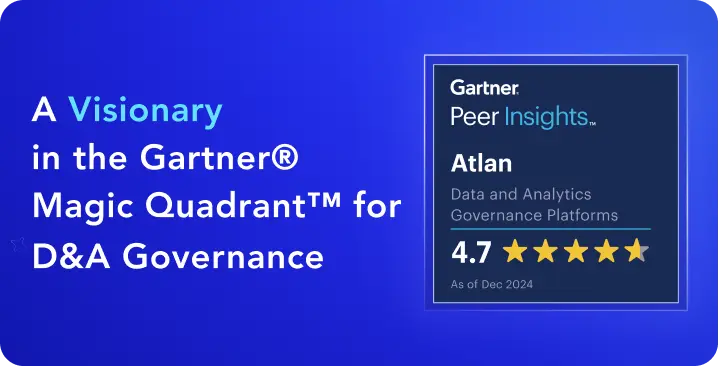Data Migration in Manufacturing: Benefits, Challenges & Importance of a Unified Control Plane
Share this article
Data migration in manufacturing is essential for modernizing operations, improving scalability, and ensuring seamless access to critical business data. Whether upgrading infrastructure, adopting new technology, or consolidating systems, a well-executed data migration strategy helps manufacturers reduce costs, enhance decision-making, and drive innovation.
See How Atlan Simplifies Data Governance ✨ – Start Product Tour
This article explores the benefits and challenges of data migration in manufacturing, followed by the role of a unified control plane in modernizing your data stack.
Table of Contents #
- What is data migration in manufacturing?
- Data migration in manufacturing: Prominent use cases
- The business benefits of data migration in manufacturing
- Top challenges of data migration in manufacturing
- Data migration in manufacturing: How a unified control plane can ensure seamless oversight
- Data migration in manufacturing: Related reads
What is data migration in manufacturing? #
Data migration in manufacturing is the process of transferring critical business information—such as production data, inventory logs, and maintenance records—from one system or storage environment to another.
Effective data migration ensures that historical production data, supply chain records, equipment logs, and quality control metrics remain accurate, accessible, and secure during transitions.
Let’s look at two examples.
In 2023, global manufacturing company 3M migrated its on-premise data centers to AWS. The company’s data centers were aging, obtaining new hardware was challenging, and there was a rising demand to increase capacity quickly. This enhanced 3M’s scalability and resiliency while saving millions of dollars through optimized costs and reduced downtime.
At Micron, a US-based memory and storage manufacturer, data volume was growing at 30% year over year, necessitating an upgrade to its data infrastructure. Micron moved from its legacy on-premise data warehouse to a cloud-built data warehouse supported by Snowflake. This reduced downtime events by over 95%, enabling them to shift 50% of database administrators from warehousing support to more strategic projects.
Data migration in manufacturing: Prominent use cases #
Data migration in manufacturing happens when an enterprise is:
- Upgrading infrastructure: Moving from legacy systems to the cloud reduces IT maintenance costs, engineering effort, and improves real-time data access. For instance, a supply chain analyst can get real-time access to accurate and updated inventory data, which helps in generating insights that prevent stock shortages.
- Adopting new technology: Migrating to modern platforms improves scalability, flexibility, and supports the adoption of automation and AI. For example, manufacturers implementing AI-driven quality control systems can use historical production data to train models, enabling automated defect detection and reducing waste in manufacturing lines.
- Setting up a unified control plane consolidating systems: A unified control plane creates a consistent layer of oversight, integrating disparate data sources and systems and powering diverse end-users across disparate tools and systems.
The business benefits of data migration in manufacturing #
Effective data migration can transform business operations and drive strategic value by improving efficiency, reducing costs, promoting innovation, and more.
Let’s look at the top benefits of data migration in manufacturing:
- Improved scalability and performance: Migrating to a cloud-based data platform allows manufacturers to scale seamlessly as operations expand.
- Cost savings and efficiency: Consolidating data infrastructure reduces storage and maintenance costs. For instance, transitioning from on-premises systems to the cloud can cut data storage expenses and improve accessibility across geographies.
- Better decision-making: Modern data platforms enable real-time insights, improving supply chain and production planning. Integrating manufacturing data across systems can lead to faster issue resolution and reduced downtime.
- Greater interoperability across the tech and data stack: Upgrading legacy systems allows manufacturers to connect with modern tools and lay the foundation for automation and AI-readiness.
- Improved compliance posture: Setting up a unified control plane for data can make regulatory compliance, audits, and reporting more efficient. For instance, such a platform can automate data retention policy enforcement, helping manufacturers meet regulatory requirements with minimal manual effort.
- Faster innovation: Migrating to modern platforms supports digital transformation by enabling AI-driven analytics, predictive maintenance, and automated quality control. For example, manufacturers can leverage AI to optimize production schedules and improve energy efficiency.
Top challenges of data migration in manufacturing #
Data migration in manufacturing is a complex endeavor with numerous challenges, such as:
- Data silos: Fragmented data across departments can slow down migration and hinder seamless integration.
- Managing large volumes of diverse data assets: Manufacturing data includes machine logs, production schedules, and supply chain records, making migration a highly intricate task
- Legacy systems with minimal documentation: Outdated systems often lack proper documentation, making it difficult to map, extract, and migrate data accurately.
- Downtime and business continuity risks: Migration projects can disrupt operations if not properly planned, leading to production delays and financial losses.
- Compliance with data security and privacy regulations: Manufacturers must follow a wide range of regulations, including GDPR, CCPA, and industry-specific standards, while ensuring sensitive data is protected during migration.
- Technical compatibility and integration: Migrated data must align with existing systems, requiring careful transformation to avoid inconsistencies in formats, structures, and workflows.
- Resource and cost management: Balancing migration costs while ensuring data quality and minimal disruption is a critical challenge for manufacturers.
- Interoperability across multiple systems: Ensuring smooth data flow between ERP, MES, IoT platforms, and cloud environments is essential for maintaining operational efficiency post-migration.
Data migration in manufacturing: How a unified control plane can ensure seamless oversight #
As mentioned earlier, manufacturers handle vast amounts of data across ERP systems, production monitoring tools, supply chain platforms, and IoT networks. Migrating these diverse data sources requires a unified control plane to maintain oversight, ensure compliance, and enable smooth operations.
A unified control plane acts as a central governance layer, aligning data security, compliance, and lineage tracking across the manufacturing ecosystem. It embeds governance into every workflow, ensuring that diverse data users–factory managers, engineers, supply chain analysts–can access the data they need without disruptions.
The key capabilities of a unified control plane that simplify data migration in manufacturing include:
- Active metadata management: Collect and manage metadata from diverse data sources – ERP, MES, IoT platforms, production databases, etc. Also, enable two-way communication between the metadata layer and the control plane, keeping all systems synchronized.
- Unified data governance: Govern all data assets from a central place where all the metadata is stored, classified, and managed. Use a centralized policy manager and transparency center to get a real-time view of policy coverage, incidents, and breaches.
- Automated data lineage: Track cross-system, column-level data lineage built on active metadata, ensuring visibility into how data transforms across systems. This is especially useful for tracking supply chain logistics or production changes.
- Real-time compliance monitoring: Monitor real-time changes to metadata and automate policy updates to maintain regulatory adherence. Also, set up automated audit trails and access logs to ensure regulatory compliance.
- Intelligent automation: Use intelligent automation for data ownership, asset classification, pipeline alerts, and metadata updates, reducing manual work and enhancing efficiency.
Summary #
Data migration can empower manufacturers to optimize operations, improve compliance, and future-proof their data infrastructure. By leveraging a unified control plane, automation, and real-time governance, manufacturers can ensure seamless data transitions, minimize risks, and unlock the full potential of modern digital manufacturing.
Data migration in manufacturing: Related reads #
- Benefits of Moving from On-Premise to Cloud
- Data Migration: On-Premise to Cloud - 10 Steps to Success
- 8 Essential Strategies to Fast-Track Your Cloud Migration Journey
- Cloud vs On-Premise vs Hybrid: Choosing the Right Data Management Approach
- Benefits of Data Governance: 4 Ways It Helps Build Great Data Teams
- Cloud Data Warehouses: Cornerstone of the Modern Data Stack
- What is data governance & why does it matter?
- 7 Best Practices for Data Governance to Follow in 2025
- Benefits of Data Governance: 4 Ways It Helps Build Great Data Teams
- Data Governance Policy: Examples, Templates & How to Write One
- Key Objectives of Data Governance: How Should You Think About Them?
- Automated Data Governance: How Does It Help You Manage Access, Security & More at Scale?
- Data Governance in Manufacturing: Challenges, Business Benefits, Essential Capabilities
- Data Migration in Banking: Your Complete 2025 Guide
- Data Migration in Fintech: Your Complete 2025 Guide
- Data Migration in Financial Services: Your Complete 2025 Guide
- Data Migration in Hospitality: Your Complete Guide to Transforming Operations and Guest Experiences
- Data Migration in Healthcare: Use Cases, Challenges, Implementation Strategy
- Unified Control Plane for Data: The Future of Data Cataloging
Share this article











